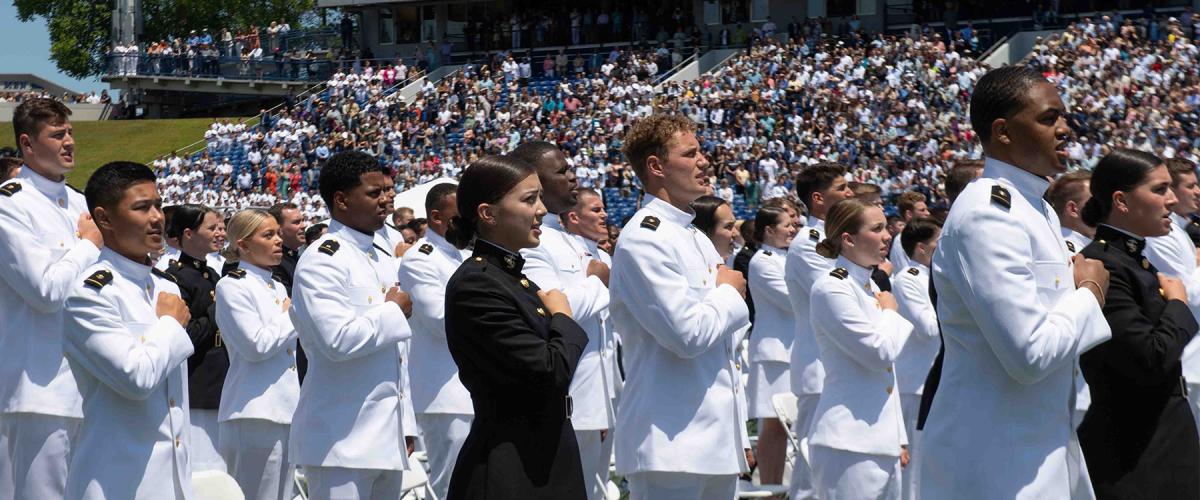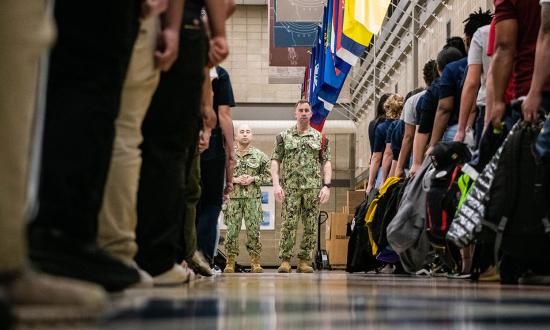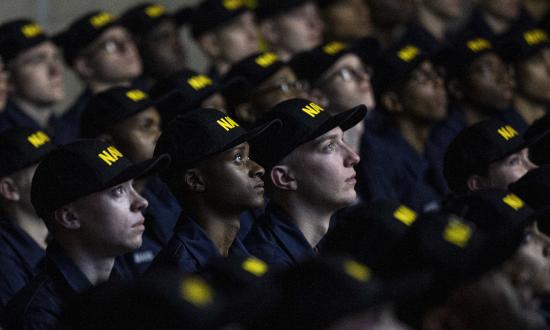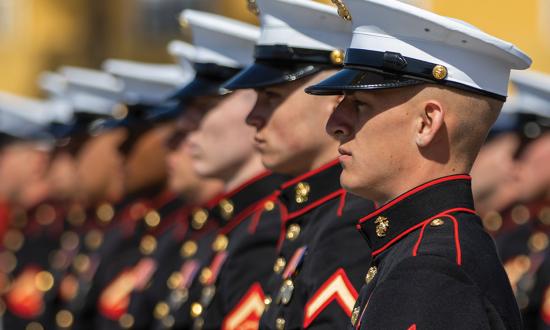The armed forces should be prepared for the end of affirmative action if the Supreme Court rules for the plaintiffs in Students for Fair Admissions v. University of North Carolina (SFFA v. UNC).1 Based on the current conservative composition of the court, and transcripts from oral arguments, it is likely the court will overturn the precedent allowing consideration of race in postsecondary education admissions. While SFFA v. UNC focuses on civilian, public academic institutions such as the University of North Carolina, the armed forces should be prepared for the retreat of race-conscious selection policies in both its service academy admissions and recruiting practices and be ready to answer the following questions: Does the military have a compelling governmental interest in achieving a certain level of racial diversity among its enlisted and officer corps? If so, are current admissions and recruiting practices narrowly tailored to meet that compelling interest?
SFFA v. UNC is the latest to challenge the two-decade-old Supreme Court decisions in Grutter v. Bollinger and Gratz v. Bollinger, which upheld the consideration of race in postsecondary education admission (colloquially known as affirmative action”).2 There is a long history of jurisprudence on regulating the U.S. government’s use of racial classifications to make decisions. While this is not a comprehensive overview, it is helpful to review the basic legal history of affirmative action, and the military’s inputs throughout, to understand the issues before the court.
Affirmative Action
In 1954, the Supreme Court case Brown v. Board of Education of Topeka established the common law precedent that segregation on the basis of race in public schools is impermissible.3 This precedent was later strengthened in statute with the Civil Rights Act of 1964, which forbids racial discrimination in any program receiving federal funding.4 In 1978, the Supreme Court decided Regents of the University of Berkeley v. Bakke Regents of the University of Berkeley v. Bakke (in which Allan Bakke, a white man denied admission to the University of California Davis School of Medicine, challenged the school’s affirmative action program), striking down the University of California’s race-conscious, quota-based admissions practice, which reserved a set number of medical school seats for minority students. However, the court kept the door open for “holistic” admissions practices that used race as one of several factors.5 Then in Gratz and Grutter, appellants petitioned against the University of Michigan for its use of race in admissions decisions for both the undergraduate university and the law school.6Gratz and Grutter effectively set the overt legal precedent that has permitted affirmative action to flourish in the two decades since they were decided.7
In these decisions, the court held that race-conscious policies must pass the “strict scrutiny” jurisprudence test, which says a governmental policy must address a “compelling governmental purpose” and be “narrowly tailored” to serve that purpose. For example, in Gratz and Grutter, the court recognized the compelling governmental interest in colleges and universities achieving “the educational benefits of student body diversity.” To be narrowly tailored, race-conscious admissions must be “necessary” to achieving those educational benefits.8 For example, consideration of an applicant’s race is not necessary if a “workable race-neutral alternative” is available—i.e., if the university “could achieve sufficient diversity without using racial classifications.”9
Like postsecondary educational institutions, the military service academies have overtly considered race in admitting students.10 In Gratz and Grutter, a collection of senior military leaders, including notable generals and admirals from each of the services and veterans serving in high political offices, penned a joint petition to advocate for race-conscious admissions policies.11
Their brief to the court spelled out the specific governmental interest the service academies and armed forces have in maintaining a force that reflects the face of the nation. The argument included a recital of the racial tensions that plagued military operations and culture during the Vietnam War, quoting retired Marine Corps Lieutenant General Frank Petersen: “In Vietnam, racial tensions reached a point where there was an inability to fight.”12 The group further argued that a community of officers that did not reflect the racial composition of the nation would lead to significant degradation of military readiness and an associated degradation of American society’s trust and support of its military. The authors made clear that even if affirmative action was not upheld in civilian higher education, the military services and service academies had a distinct and compelling governmental interest: ensuring a racially diverse officer corps to avoid the racial tensions and societal distrust that afflicted the armed forces during the Vietnam war. The parties cited a 1981 Supreme Court case that hammered this point: “It is obvious and unarguable that no governmental interest is more compelling than the security of the Nation.”13
Understanding the deference the courts give to the pursuit of national security, in Gutter and Gratz, a brief from a similar group of military leaders said the service academies and ROTC programs “employ race as a factor in recruiting and admissions policies and decisions.”14 These race-conscious policies included considering desired class compositions of racial minorities and women in its selection of applicants. Furthermore, this group of military advocates argued there were no alternatives to the consideration of race in service academy admission to achieve the requisite racial diversity. We must assess if these arguments still ring true today.
Race-Neutral Practices
It has been 20 years since the Gratz and Grutter decisions. In SFFA v. UNC, the appellants argue that, in that time, multiple universities have proven that race-conscious admissions practices are not the only or even the most effective way to achieve diversity on campus.15 For example, the appellants cite the University of California, Berkeley’s decision to preclude the use of race as a factor in admissions. Despite race-neutral admissions practices, in 2021, Berkeley admitted its most diverse class in the institution’s history.16 The appellants also identified several other race-neutral practices that could achieve diversity, including increasing admissions outreach to racial minority communities, using zip codes as a corollary for diversity, or weighting attendance at specific high schools.
In SFFA v. UNC, a group of flag officers again submitted a brief to the court addressing the military’s separate and more compelling government interest in racial diversity and argues in support of upholding the affirmative action precedent.17 This brief curtails its description of service academy admissions practices. Instead of stating that service academies “employ race as a factor in recruiting and admission policies and decisions,” it uses the term “modest race-conscious admissions policies” to describe service academy admissions.18 While this brief strongly supports race-conscious admissions, it does not address any more narrowly tailored alternatives that could meet the government’s compelling interest in a diverse population of servicemembers.
While the military’s experiences with desegregation and the turmoil it faced when operating with a racially diverse enlisted force led by a monochromatic officer corps are irrefutable, the “modest race-conscious policies” that military recruiting, service academies, and ROTC programs use may no longer be tailored narrowly enough to meet the compelling governmental interest of national security. The SFFA v. UNC appellants’ arguments show that universities have been able to achieve racial diversity through race-neutral means. If the Supreme Court concurs and overturns the precedent allowing overt race-conscious admissions, the armed forces should prepare alternatives to its own overtly race conscious policies.
Continuing to actively recruit among racial minority communities would not run afoul of a post-Gratz/Grutter legal regime. However, race-conscious selection of applicants for attendance at the service academies or for receipt of ROTC scholarships likely would not be seen as a narrowly tailored means to achieve the compelling governmental interest of racial diversity in the Military armed Servicesforces. Multiple academic institutions have shown that race-neutral admissions practices can achieve racial diversity.19 Despite arguing that achieving racial diversity is nearly impossible without race-conscious admissions practices, In addition to the University of California, Berkeley, the Texas and Oklahoma state university systems contend their admissions practices have achieved student body racial diversity with race-neutral practices. Workable alternatives to race-conscious admissions practices do exist. Thus, the service academies’ current “modest race-conscious policies” are not narrowly tailored enough to meet the compelling governmental interest of achieving the warfighting benefits of racial diversity.
The military has a compelling interest in a diverse population of enlisted and officer service members. However, it is not clear that race-conscious admissions or selection practices are narrowly tailored to meet that end. If the Gratz and Grutter precedents are overturned, the armed forces should be prepared to implement race-neutral admissions policies and bolster recruiting and outreach activities to continue to promote military service to all Americans.
1. “Students for Fair Admissions v. University of North Carolina,” Oyez, 31 October 2022.
2. Gratz v. Bollinger, 539 U.S. 244 (2003); and Grutter v. Bollinger, 539 U.S. 306 (2003).
3. Brown v. Board of Education of Topeka, 349 U.S. 294 (1955).
4. 42 U.S. Code § 2000d.
5. Regents of University of California v. Bakke, 438 U.S. 265 (1978).
6. Gratz v. Bollinger; Grutter v. Bollinger.
7. Gratz v. Bollinger; Grutter v. Bollinger.
8. Grutter v. Bollinger.
9. Grutter v. Bollinger.
10. Consolidated Brief of Lieutenant General Julius W. Becton, Jr. et al., Grutter (Nos. 02-241 & 02-516).
11. Consolidated Brief of Lieutenant General Julius W. Becton, Jr.
12. David Maraniss, “U.S. Military Struggles to Make Equality Work,” Washington Post, 6 March 1990.
13. Maraniss, “U.S. Military Struggles to Make Equality Work,”; and Haig v. Agee, 453 U.S. 280 (1981).
14. Consolidated Brief of Lieutenant General Julius W. Becton, Jr.
15. Brief for Respondent-Students, Students for Fair Admissions, Inc. (No. 21-707).
16. Janet Gilmore, “In a Pandemic Year, UC Berkeley Admits Another Outstanding, More Diverse Class,” Berkeley News, 19 July 2021.
17. Consolidated Brief of Admiral Charles S. Abbot et al., Students for Fair Admissions, Inc. (No. 21-707).
18. Consolidated Brief of Admiral Charles S. Abbot.
19. Consolidated Brief of Admiral Charles S. Abbot.






